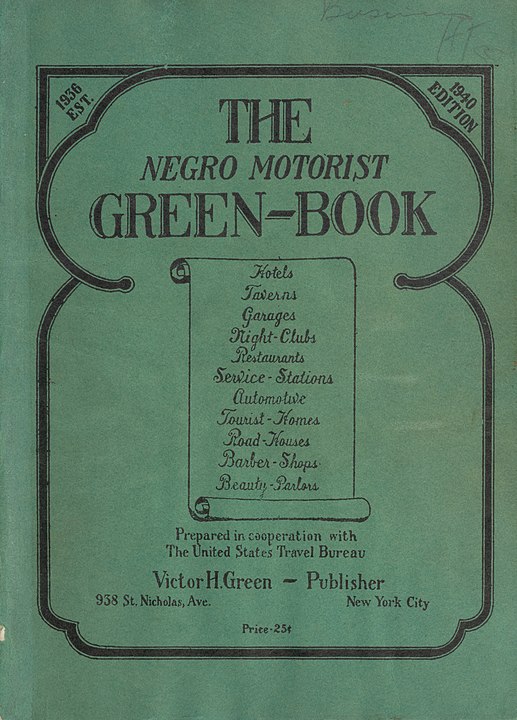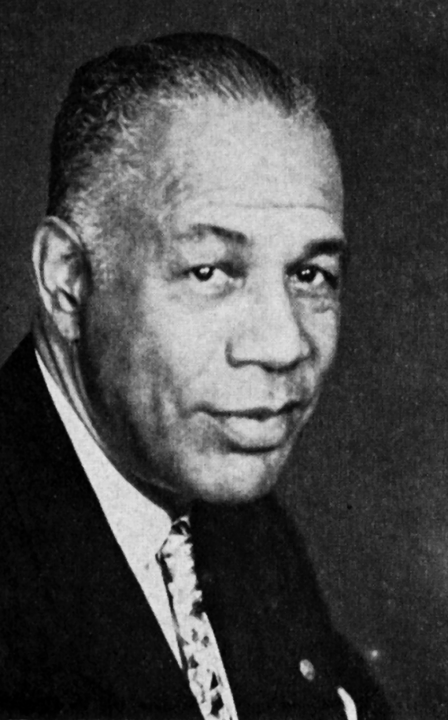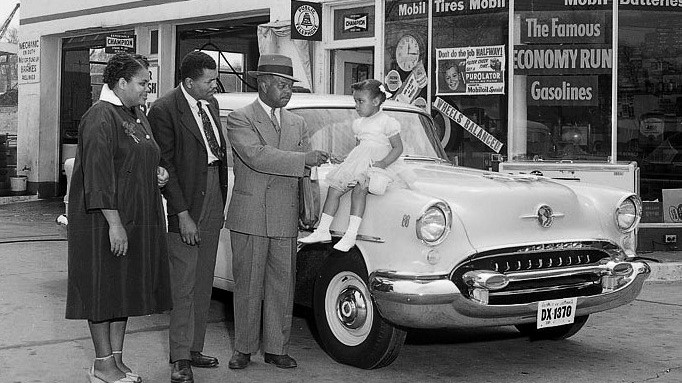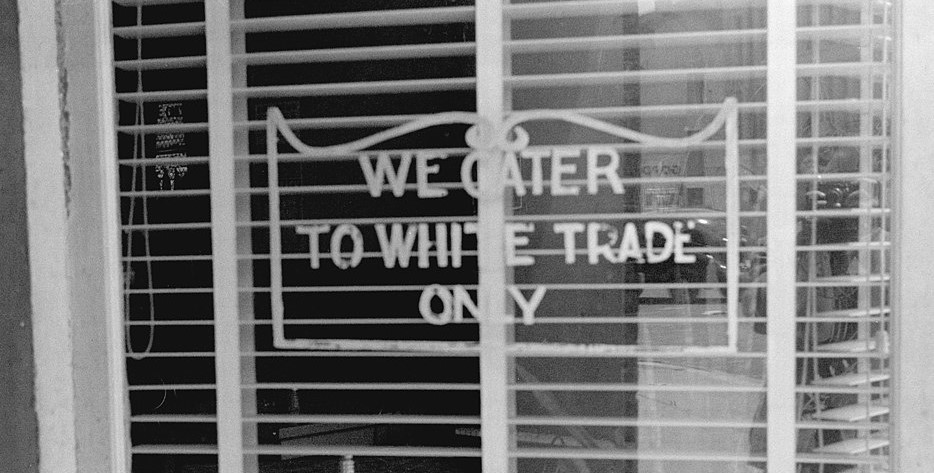Dubbed the “AAA guide for black people,” the underground travel manual encapsulated how automobile travel expanded — and limited — African American lives under Jim Crow.
-
Summer 2021
Volume65Issue5
Editor's Note: Candacy Taylor is an award-winning author, photographer, and cultural documentarian. The following is an excerpt from her most recent book, titled the Overground Railroad: The Green Book and the Roots of Black Travel in America, published by Abrams Books.

“Don't you dare say a word.” Ron was sitting in the back seat as his father pulled the car to a stop at the side of the road. His father had told him to be quiet before, but this was the first time Ron felt the words reverberate to the pit of his stomach. Moments later, the sheriff stood over the well-appointed 1953 Chevy sedan complete with all the modern features you read about in the magazines.
“Where did you get this vehicle? What are you doing here? And who are these people with you?” the sheriff asked. Ron’s father answered, “It’s my employer’s car.” He pointed to his wife, sitting upright and expressionless in the passenger seat. He pretended that she wasn’t his wife and said, “This is my employer’s maid, and that is her son in the back. I’m taking them home.”
The sheriff took a long, hard look at Ron’s mother and then angled his eyes to the back seat. A young Ronald sat tight-lipped, too afraid to turn his head or even take a breath. “Where’s your hat?” the sheriff barked at Ron’s dad.
“Hanging up right behind me in the back seat, officer.” The sheriff waved. “All right. Move on.”
As they drove north across the Tennessee border, a sad, eerie silence hung in the air. Ron watched Daddy and Mama exchange knowing glances and then turned his head to look at the black, unassuming cap that had been hanging next to him in the back seat ever since he could remember. It wasn’t until that moment that he realized why he had never seen his father wearing it. Mama wasn’t a maid, and Daddy wasn’t a driver. He had a good job with the railroad, and this was their family car.
Until that day, Ron never paid attention to that cap, but now he realized that it wasn’t just any hat. It was a chauffeur’s hat. A ruse, a prop — a lifesaver.
During the Jim Crow era, the chauffeur’s hat was the perfect cover for every middle-class black man pulled over and harassed by the police. If Ron’s father had told the sheriff the truth — that he was driving his own car and that they were a family on vacation — the sheriff wouldn’t have believed him. He would have assumed the car was stolen.
In the event that the sheriff did believe it was Ron’s father’s car, the rage and jealousy he might have felt at the thought of a black man owning a nicer car than a police officer might have triggered a beating, torture, or even murder. From that day on, Ron noticed these hats strategically placed, like unarmed weapons, in the back seat of nearly every black man’s car.

Ron Burford was my stepfather. I had known this man for more than thirty years, but this was the first time he had told me anything about the pain of growing up in the Jim Crow South.
I think Ron started to trust me around 2014, soon after I called home asking about the Green Book. I had just seen a copy of it for the first time, tucked away under glass at the Autry Museum of the American West, in Los Angeles. It was a travel guide that was published for black people during the Jim Crow era. I’d never known such a thing existed.
Right after leaving the Autry, I called my parents in Columbus, Ohio, and asked Ron if he had ever used the Green Book. He said, “I’m not sure; probably. There were a few black guides back then.”
He was right. There were about a dozen other black travel guides, but the Green Book was in print for the longest period of time and had the widest readership. Victor Hugo Green, a man with a seventh-grade education, published the first Green Book, in Harlem in 1936, and he worked on it until his death in 1960. His wife, Alma, took up the mantle and kept the Green Book going until 1962.
In 1965, Langley Waller, an engraver and former writer for Harlem’s newspaper the New York Amsterdam News, published the last two editions of the Green Book, the 1963–64 and 1966–67 editions. (There was no 1965 edition.). Although these are distinctly different in design, scope, and tone from the original, what never wavered throughout the life of the Green Book was the courage and security it afforded black people, so they could pack up their cars and go.
The Green Book was published during a time when car travel symbolized freedom in America, but since racial segregation was in full force throughout the country, the open road wasn’t open to all. When black motorists picked up a copy of the Green Book, they were greeted by the words “Just What You Have Been Looking For!! NOW WE CAN TRAVEL WITHOUT EMBARRASSMENT.”
The Green Book was called the AAA guide for black people, but it was much more. The businesses listed in it were critical sources of refuge along lonely stretches of America’s perilously empty roads. To stay safe, black folks never left home without a plan, props, a cover story, and a copy of the Green Book.
When the first edition of the Green Book came out, there were nearly thirty million cars on the road. In January of the following year, Franklin D. Roosevelt was inaugurated into a second term as U.S. president, and despite the dust storms that suffocated the state of Oklahoma and a catastrophic flood that swallowed parts of Mississippi, Ohio, Kentucky, and Illinois, many Americans, black and white, were optimistic about the future. Nearly a decade had passed since the Great Depression, and unemployment had dropped to 14.3 percent from almost 20 percent in 1936; and although three and a half million black families (approximately 30 percent of the black population) were on government assistance, black employment was the highest it had been since the Great Depression.

There was a clear market for car-related businesses in the late thirties because by then, 85 percent of Americans vacationed by car. This helped to make the automobile industry one of the leading industries in the world. But even more important, a vehicle provided black families with the freedom and job opportunities they needed to pull themselves out of the servant class and into a stable middle-class lifestyle.
The 1938 Green Book published an article, “The Automobile and What It Has Done for the Negro,” by Benj. J. Thomas, the proprietor of the Broadway Auto School. In the article, Thomas writes, “In New York City alone, one third of the Mechanical work is being done by Colored men. The automobile has been a special blessing to the Negro . . . 25 years ago, the average young colored man was doing porter work, bell hopping, running an elevator or waiting on table[s], and the average wage at that time was $5 per week.”
And though automobiles during this time could be expensive, the freedom that came with owning a car was worth the sacrifice to many black Americans. Having a car shielded them from physical harm, humiliation, harassment, and the psychological terror of a segregated America. With a car, they had an option other than being corralled into subpar seating on buses, streetcars, trolleys, and trains that were almost guaranteed to be uncomfortable and dirty
By 1930, blacks in the United States owned approximately 70,000 small businesses, and over the Green Book’s nearly thirty-year reign, it listed more than 9,500 of these, including hotels, restaurants, gas stations, department stores, tailors, nightclubs, drugstores, hair salons, haberdashers, sanitariums, funeral homes, real estate offices, and even a dude ranch.
More than 80 percent of the listings were clustered in traditional African American neighborhoods such as Harlem, South Central Los Angeles, and Bronzeville in Chicago. The majority were black-owned, but there were also black-friendly white-owned establishments, such as Macy’s, Brooks Brothers, the Drake Hotel in Chicago, the Hotel Bel-Air in Los Angeles, and even Disneyland.
Victor Green created his guide in this era of optimism, and the first two editions were centered on New York City’s Harlem, where he and Alma lived.
Listings in the Green Book blanketed the entire United States, and later editions included Canada, the Virgin Islands, Europe, and Africa. The guide was distributed by mail order, sold by black-owned businesses, and made available through a savvy media campaign led by Esso gas stations (which operate as ExxonMobil today). It was successful due to word of mouth but also as a result of an ambitious grassroots operation of a national network of mailmen led by the guide’s creator, and fellow postal worker, Victor Hugo Green. This multipronged marketing strategy was so effective that by 1962, the Green Book had a circulation of nearly two million.
The 1937 edition was unusual for a travel guide. Only fifteen pages long, it listed more automobile businesses than travel sites. Eighteen of the twenty ads in the first five pages were Harlem-based mechanics, fender and body workers, ignition specialists, welders, tow service providers, and auto painters. (The two non-auto-related ads were for a radio repair shop and a store specializing in an entirely different sort of wheels: Hollis’ Bicycle Store, owned by Harri Hollis, who described himself as a “Colored Pro Bike Champ.”)
On the first page of the 1937 Green Book, Victor Green’s introduction called on readers to “get together and make Motoring better.” Yet preparation for a road trip required extra work for black motorists planning to travel through a state with only a few Green Book listings. They had to prepare for inconveniences and even atrocities that white motorists never had to consider. Even if there was a black-friendly motel or tourist home listed, there were no guarantees it would have space available. And there was no way to reserve a spot, as most Green Book listings didn’t include phone numbers.
Black families therefore would spend weeks preparing to travel America’s byways. They’d pack sheets and blankets, which doubled as privacy partitions in case they had no choice but to relieve themselves on the side of the road. And because there was no guarantee they would find a restaurant, food was packed in ice and placed in “shoebox lunches.”
Herbert Sulaiman remembers traveling with his parents as a child. “You had to be prepared,” he said. “Traveling in those days meant the women would fix food at night. They’d fill the thermos jugs, you had eggs, fixed ham sandwiches and turkey sandwiches and fried chicken.”
Despite the uncertainty of what black travelers might encounter on the road, the Green Book focused on solutions rather than problems. Its tone was never threatening, and there was no mention of the dire consequences of being stranded or denied service. Instead, a lighthearted spirit can be found throughout the 1937 edition, which was printed entirely in green ink.
One of the Green Book’s most amusing pieces was found in “How to Keep from Growing Old.” This tongue-in-cheek column appeared in the first four editions of the Green Book and sporadically throughout the life of the guide. Keenly aware of the hazards of irresponsible driving, Green spent most pages of his Green Books telling motorists what they should do to ensure arrival at their destination with minimal-to-no damage to themselves or their vehicle. However, “How to Keep from Growing Old” told them what they shouldn’t do.
Unfortunately, we know very little about Victor Green, so we can only speculate about what he decided to put in his guide. “How to Keep from Growing Old,” though, gives us a window into Green’s sense of humor, because he reminds readers to find humor and fun wherever they could.
When the Queen of Soul, Aretha Franklin, traveled with her father as a child, she remembered that “the traveling was and wasn’t fun . . . we couldn’t eat in the restaurants in the South and so we had to go in the market to get what you called ‘souse’ [hogshead cheese] and white saltine crackers. But listen, darling, I loved souse . . . that was fun. We’d laugh right on down the highway and still have a good time.”

In addition to having fun, Green cheerfully cautioned drivers to be on the alert at all times for bad or distracted drivers. In a fifteen-point checklist of “Safe Driving Rules” he published in the 1938 edition, he gives readers clues about ways to stay safe, writing, “Watch out for the driver who crosses the White Line,” and “Remember that Junior thinks that the ignition key is something to play with.”
On page 3 of the 1937 edition, the article “Prepardness” [sic] begins with “An Ounce of Prevention is worth more than a Pound of Cure,” a play on the familiar saying. In the article, Green outlines the importance of getting a proper tune-up and lays out the procedures for those unfamiliar with car maintenance. The tips are thorough, and the advice is practical and positive. “Be prepared before you start, and more than likely you will have a pleasant and enjoyable trip with no regrets when you return.”
Also in “Prepardness,” [sic] Green emphasizes the importance of checking the car’s brakes, steering, and the condition of the tires before hitting the road. He instructs readers to carry a spare set of head light bulbs and fuses, because although the car “may appear to be in good working order, long-distance trips can cause minor, unnoticeable faults to quickly turn into major breakdowns . . . Nothing is more of a killjoy [than] when the motor starts to spit and pop and then stops.”
Underlying his sound mechanical advice is Green’s full awareness that for black drivers, being stranded wasn’t just an inconvenience. Depending on where they were, it could mean life or death. In the late 1930s, the federal Interstate Highway System hadn’t been developed yet, so cross-country travel required driving long distances on county roads, and then along small town Main Streets, where black families were much more vulnerable to run-ins with the local sheriffs.
A huge concern for black motorists was getting stranded in a “sundown town,” an all-white enclave that banned black people from entering after dark. Thousands of sundown towns were scattered throughout the country. Harvard sociologist James Loewen, in his book Sundown Towns, defines a sundown town as a city, town, or village that had nine or fewer black residents. He also traces towns whose black populations virtually vanished within twenty-four hours of a mob lynching or riot, usually because they were fleeing angry white mobs.
Loewen writes that sundown towns were largely a northern construct, starting in about 1890 and lasting well into the 1960s. In fact, he found hundreds of sundown towns in Illinois alone. The five states with the most sundown towns were Ohio, Kansas, California, Missouri, and Nebraska. Ironically, Mississippi, a state that became a global symbol of terrorism and white supremacy, had only thirteen sundown towns.
Most sundown towns made it very clear that black people were not welcome. Some posted signs at the county line reading, "ni--r, don’t let the sun go down on you here, understand?" Others, such as Villa Grove, Illinois, and Gardnerville, Nevada, rang a bell at six pm that warned black laborers and domestics to leave.
Nearly all the sundown towns are gone now, but even in 2019 there are still communities that are hostile to black people. In the northwestern corner of Arkansas, for example, Harrison, a modern-day Klan town in the Ozarks, is littered with white supremacists. Black residents were run out of Harrison after two race riots, in 1905 and 1909, and in 2010, among its 12,943 residents, 96 percent were white. Today, Harrison is home to at least four hate groups, including the Knights Party Veterans League, the Soldiers of the Cross Training Institute, and David Duke’s Knights of the Ku Klux Klan.

While I was driving through Arkansas scouting Green Book sites, I took the Harrison exit off Highway 65. The town motto, “Adventure awaits you,” unnerved me. I didn’t see a sundown town sign, but there was an enormous white billboard on the highway with a large black X on a white background and the word secede. I thought it looked familiar; then I realized that the X was the same graphic printed on the flags carried by white supremacists at the 2017 riot in Charlottesville, Virginia, where Heather Heyer, a white counterprotester, was murdered.
When fresh-faced neo-Nazis in all-American khakis carrying lit Tiki torches marched through the streets of Charlottesville, people could no longer deny the role white supremacy was still playing in America. Millions were horrified at the brazen violence and the crowd chanting, “Jews will not replace us!” When President Trump refused to denounce the neo-Nazis unequivocally, the United States’ image as a beacon of diversity and equality was spoiled for most Americans. We wanted to believe that the election of Barack Obama had finally solved our race problem. It had not. The events of Charlottesville had swung the pendulum undeniably back to the nation’s white supremacist roots.
The Green Book included listings for twelve Charlottesville sites over the three decades it was in publication: four tourist homes, two dance halls, two hotels, a beauty shop, a barbershop, and two theaters. One of the theaters, the Paramount, still stands today. During the late 1930s, black patrons entered the theater through the side door and had to walk up a small, unlit stairway to the balcony and sit in the “Colored” section. Black patrons were also forced to use a separate concession area, separate restrooms, and even separate emergency exits. Although black patrons were segregated at the Paramount Theater, blacks could at least patronize it, which was not true of many of the city’s other establishments.
Despite the overt racism Victor Green must have experienced during his life, he had reason to be optimistic. Just a few years before he created the Green Book, the concept of the American Dream was born. It was defined by James Truslow Adams in 1931 as “a dream of social order in which each man and each woman shall be able to attain to the fullest stature of which they are innately capable, and be recognized by others for what they are, regardless of the fortuitous circumstances of birth or position.” It was an ambitious goal, but Americans from all races and classes wanted to believe in the American Dream. Remember, there was no established civil rights movement in the 1930s, no Dr. Martin Luther King Jr., so to be a black business owner during the Jim Crow era was the highest expression of the American Dream.
It took another thirty-three years before Adams’s dream of social equality would be written into law as the 1964 Civil Rights Act. Unfortunately, Victor Green died in 1960, so he didn’t live to see racial integration. But if he had, it may have broken his heart, because after integration became law, racism continued to shape America’s social, political, and physical spaces. The Federal Housing Administration redlined neighborhoods, denying housing loans to blacks and preventing them from accessing the same wealth-building opportunities freely given to whites.
More recently, there have been brazen attempts to dismantle the 1965 Voting Rights Act. And unconstitutional policing policies such as “stop and frisk” have caused the prison population to skyrocket 700 percent, and today, as a result, nearly one in three black men is incarcerated.
When I talk about the Green Book, some people say, “Thank god we don’t need that anymore.” And yes, it is true that we have made progress, but some of the communities that were once safe havens for black people are now just as dangerous as the sundown towns blacks were avoiding during the second wave of the Great Migration.
The Green Book deserves special attention now because our past and current policies shape how not just black people but people of all races and gender identities navigate this country.

